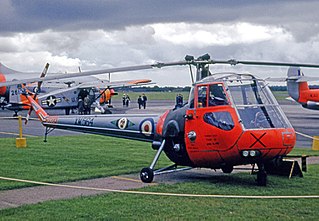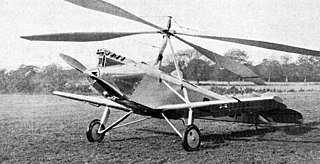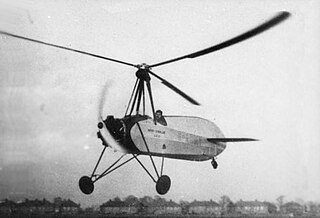
The Cierva C.30 is an autogyro designed by Juan de la Cierva and built under licence from the Cierva Autogiro Company by A V Roe & Co Ltd (Avro), Lioré-et-Olivier and Focke-Wulf.

The Saunders-Roe Skeeter is a two-seat training and scout helicopter that was developed and produced by British manufacturer Saunders-Roe ("Saro") of Cowes and Southampton, in the United Kingdom.

The General Aircraft GAL.45 Owlet was a 1940s British single-engined trainer aircraft built by General Aircraft Limited at London Air Park, Hanworth.

The Pitcairn OP-1 was the first rotary-wing aircraft to be seriously evaluated by any of the world's major air forces. The machine was not a helicopter, nor an airplane, but an autogyro. Pitcairn's model was never put into production for any military.

The Cierva W.11 Air Horse was a helicopter developed by the Cierva Autogiro Company in the United Kingdom during the mid-1940s. The largest helicopter in the world at the time of its debut, the Air Horse was unusual for using three rotors mounted on outriggers, and driven by a single engine mounted inside the fuselage.

The Fairey FB-1 Gyrodyne is an experimental British rotorcraft that used single lifting rotor and a tractor propeller mounted on the tip of the starboard stub wing to provide both propulsion and anti-torque reaction.

The Cierva C.8 was an experimental autogyro built by Juan de la Cierva in England in 1926 in association with Avro. Like Cierva's earlier autogyros, the C.8s were based on existing fixed-wing aircraft fuselages – in this case, the Avro 552.

The Cierva C.17 was a British experimental autogyro built by Cierva Autogiro Company in England in 1928, in association with Avro. It was an attempt to build upon the successful Cierva C.8 design using the smaller, more streamlined fuselage of an Avro Avian IIIA as a starting point. The type was found to be underpowered, and when the first attempt at fitting a more powerful engine still did not result in acceptable performance, the design was abandoned.

The Cierva C.19 was a 1930s British two-seat autogyro, designed by Spanish engineer Juan de la Cierva. It was built by Avro as the Avro Type 620. It proved to be the most successful and widely produced of the early de la Cierva designs.

The Cierva CR Twin was a five-seat utility helicopter that first flew in the UK in 1969. It was a joint development between Cierva Autogiro Company and Rotorcraft now a subsidiary of Cierva, based on the dynamic systems of the latter company's Grasshopper design. A new, highly streamlined pod-and-boom fuselage was married to the Grasshopper's coaxial rotor system, and the new aircraft registered G-AWRP first flew on 18 August 1969.

The Kellett KD-1 was a 1930s American autogyro built by the Kellett Autogiro Company. It had the distinction of being the first practical rotary-wing aircraft used by the United States Army and inaugurated the first scheduled air-mail service using a rotary-wing aircraft.

The Kellett K-2 was a two-seat autogyro developed in the United States in the early 1930s. Later examples were designated K-3 and K-4 when equipped with more powerful engines. K-3 NC 12691 is seen in the 1934 movie, It Happened One Night.

The de Havilland C.24 was a two-seat autogyro built by de Havilland at its Stag Lane works in England in 1931

The Pitcairn PA-34 and Pitcairn PA-33, given the United States Navy (USN) designation Pitcairn OP-2 and United States Army designation Pitcairn YG-2 respectively were reconnaissance autogyros designed and built in 1936 for evaluation.

The Pitcairn PCA-2 was an autogyro developed in the United States in the early 1930s. It was Harold F. Pitcairn's first autogyro design to be sold in quantity. It had a conventional design for its day – an airplane-like fuselage with two open cockpits in tandem, and an engine mounted tractor-fashion in the nose. The lift by the four-blade main rotor was augmented by stubby, low-set monoplane wings that also carried the control surfaces. The wingtips featured considerable dihedral that acted as winglets for added stability.

The British Aircraft B.A.IV Double Eagle was a British twin-engined six-seater monoplane designed and built by the British Aircraft Manufacturing Company of London Air Park, Hanworth, England.

The Hafner A.R.III Gyroplane was a British 1930s experimental autogyro designed by Austrian Raoul Hafner, and built by the A.R.III Construction Company at Denham, Buckinghamshire.
The Cierva C.29 was a five-seat British cabin autogyro built in 1934 as a joint venture between Westland Aircraft and Cierva. The rotor system and rotors were designed by Cierva and the fuselage by Westland. It was powered by a 600 hp (447 kW) Armstrong Siddeley Panther II engine with a two-bladed tractor propeller; the engine also drove the three-bladed rotor via a clutched shaft. The C.29 suffered from ground resonance during ground running and was not flown. It was later acquired for evaluation by the Royal Aircraft Establishment but it was unable to cure the resonance problem and the autogyro was scrapped in 1939.
The Westland CL.20 was a two-seat autogyro designed and built by Westland Aircraft between 1934 and 1938. One flying prototype and six airframes were built, which had control problems and insufficient lift. Before these problems could be solved the programme was abandoned and the prototype was scrapped in 1938.

The Cierva C.7 was an experimental autogiro designed by Juan de la Cierva and built in the late 1920s.


















